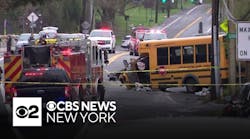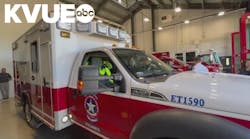One thing you can count on as a firefighter: you never know what the new shift will bring. Usually, it's a variety of medical calls, a small fire or two and maybe a vehicle accident.
But on the morning of May 16, 1997, Metro-Dade Fire Rescue (MDFR) in Miami embarked on a day-long incident that would pull resources from all corners of its nearly 2,000-square-mile territory.
Dispatcher: "Attention This is a building assignment with an additional rescue unit. It's being reported as a building collapse, and there are people injured."
The Biscayne Kennel Club, a very large and old structure that had served as a dog racing track, was being demolished to make room for an expanding private university to the east. MDFR crews knew the building was being destroyed and in fact had trained at the location several times. That knowledge still didn't prepare them for what they were about to encounter. The first units arrived within one minute, and confirmed everyone's worst fear.
Rescue 19: "Show us arrival in front of the structure. We do have a collapse show this unit command on the north side of the building."
As the crews from Rescue 19 began assessing the scene, other units started to arrive and establish different sectors.
Rescue 30: "South sector to command. Be advised that we have a major collapse and that we have four people confirmed trapped on this side. We're going to need TRT (Tactical Rescue Team) and heavy equipment to do any type of extricating here."
"When we arrived, the scene was just indescribable, something I had never seen before myself," said Firefighter Tom Sticco of Engine 20, one of the first units on the scene. "I knew the building was being demolished and that workers were inside, so I was thinking this was going to be a major operation with approximately 10 to 15 victims trapped."
With the severity and size of the collapse, and the knowledge that there were actually five victims confirmed inside, the incident commander, now a battalion chief, called for reinforcements. He ordered the dispatch of all three TRT units and Hazmat, and asked that the Special Operations Division begin mobilizing its Urban Search and Rescue Team, Florida Task Force 1 (FTF-1). Thirty members of the task force were told to stage at nearby Station 19 while the equipment, structural engineers and trauma physicians were sent directly to the scene.
"There is no doubt that the experience and knowledge gained on our missions in Oklahoma City and the recent building collapse in Puerto Rico (see page 88), just to name two, enhanced our capabilities on this incident," said MDFR Chief Dave Paulison. "But most of the responding crews were not task force members and they did an outstanding job of assessing the situation, establishing an ICS (incident command system), requesting the necessary resources and eventually removing all of the victims."
With the necessary units and resources enroute, the on-scene crews immediately began the task of finding the five victims. Eyewitnesses reported seeing them in two locations, on the southwest and southwest corners on the building. Two separate rescue scenes were established as rescue workers made their way into the rubble. Shouts for help in the southeast section allowed crews in that area to quickly find two victims, while rescue crews on the southwest corner found one victim who was lightly trapped, and who pointed to the area of the other two victims.
As the radio transmission filled with requests for air chisels and K-12 saws, rescue crews began removing the loose sheets of metal and wood beams from the patients. One man in the southwest corner was able to walk out of the structure once he was freed. The two other victims in that area were deeper inside and buried under much more material. After what seemed like hours of work but was actually 10-15 minutes, rescue crews reached the two victims.
"After we found them and got them cut out from the sheet metal we found that neither of them was breathing and one of them had a crushed chest," said Lieutenant Tom Sanders of Engine 19. "One victim was found about five minutes after the first, in a void." Both were pronounced dead.
Recovery efforts in that section of the structure were immediately stopped as it now became a crime scene. Rescue crews began making their way over the southeast corner to assist in efforts there.
In that area, rescue workers had located and were in the process of extricating the last two patients. The first man, who was only lightly pinned, was freed almost immediately. He was conscious and alert, and was quickly placed on a backboard, packaged and taken to a waiting ambulance for transport.
The second man was also conscious and alert but was pinned on his stomach from the waist down. Firefighter Jose Alvarez was one of the rescuers.
"We got the person who wasn't trapped out of there, and at the same time determined the type of equipment necessary to remove the other victims," Alvarez said. "We knew we'd need the air chisel and K-12 saw. The patient never lost consciousness and his chief complaint was a hurt head. But we talked to him the whole time and reassured him that everything was OK."
While rescue workers made sure that the patient stayed alert and maintained a clear airway, two department construction experts were brought to the rescue site. With as many as eight firefighters filling the voids in the wreckage, they wanted to be certain the structure was stable before any cuts were made to free the patient. Besides the threat of further collapse, there were other safety concerns.
"We had multiple hazards," said Captain Jeff Strickland, MDFR's TRT leader and Rescue Sector officer at this incident. "We had overhead hazards and had the possibility of doing shoring. We found out there were multiple oxygen and propane cylinders, so before we began cutting, we had to address the hazmat issue. And we had to evaluate our proper respiratory protection for possible asbestos."
After the concerns were mitigated, rescue crews using the K-12 saw were able to free the patient without problems. He remained alert during the entire time and was immediately packaged and taken to a waiting rescue for transport.
With the three live victims now extricated and transported to the hospital (all in satisfactory or good condition) and the two bodies located, MDFR sent two of its canine units into the rubble to search for any additional victims. The building had been vacant for months and it was known to be occupied by the homeless at night. While this task was being performed, MDFR was dealing with another situation that comes with such a large incident: the news media.
Within moments of the initial dispatch, representatives from South Florida's television, radio and print media outlets descended on the scene from both the land and the air. This large media crowd presented unique problems.
The number of reporters and their live-broadcast trucks vastly outnumbered the space and resources available to deal with them. A portion of the Kennel Club's parking lot was already fenced off, and reporters were kept on the opposite side, restricting their access to the scene so that they would not interfere with the rescue operation. Two public information officers (PIOs) were dedicated to media relations, gathering information from the command post and briefing the media regularly. Since the incident occurred in the morning, many local television stations broke into regular programming to carry the incident live. Reporters also needed information and video from their midday newscasts, and CNN carried the story throughout the day.
Meanwhile, high above, helicopters from all the television stations jockeyed for position and the best camera angle. The noise from the many aircraft, sometimes as many as six, made it difficult for rescue workers to hear radio transmissions and, more important, caused hanging sections of the building to vibrate. Once rescue workers realized the effect that the helicopters were having on their efforts, PIOs on the scene and at MDFR headquarters immediately asked the news agencies to move the helicopters back. All cooperated within a few minutes.
As the canine units completed their tasks and the two deceased victims were removed, MDFR began breaking down and prepared to turn the entire scene over to the police homicide unit. The specialized equipment cache of FTF-1, including fiber-optic cameras and sensitive listening gear, was packed away to be used for another mission.
"With the initial assessment and requests for the heavy equipment, we were happy that we had these resources and quickly dispatched them," Paulison said. "But as it turns out, all the victims were removed with air chisels, K-12 saws and other standard TRT tools we carry on our units."
When it was all over, the eight-hour incident required 40 MDFR units from locations throughout the county. The quick assessment, elimination of the hazards and implementation of the action plan allowed rescuers to remove the patients in the least dangerous and most efficient way possible.
Keith Bowermaster is a public information officer for Metro-Dade Fire Rescue.










